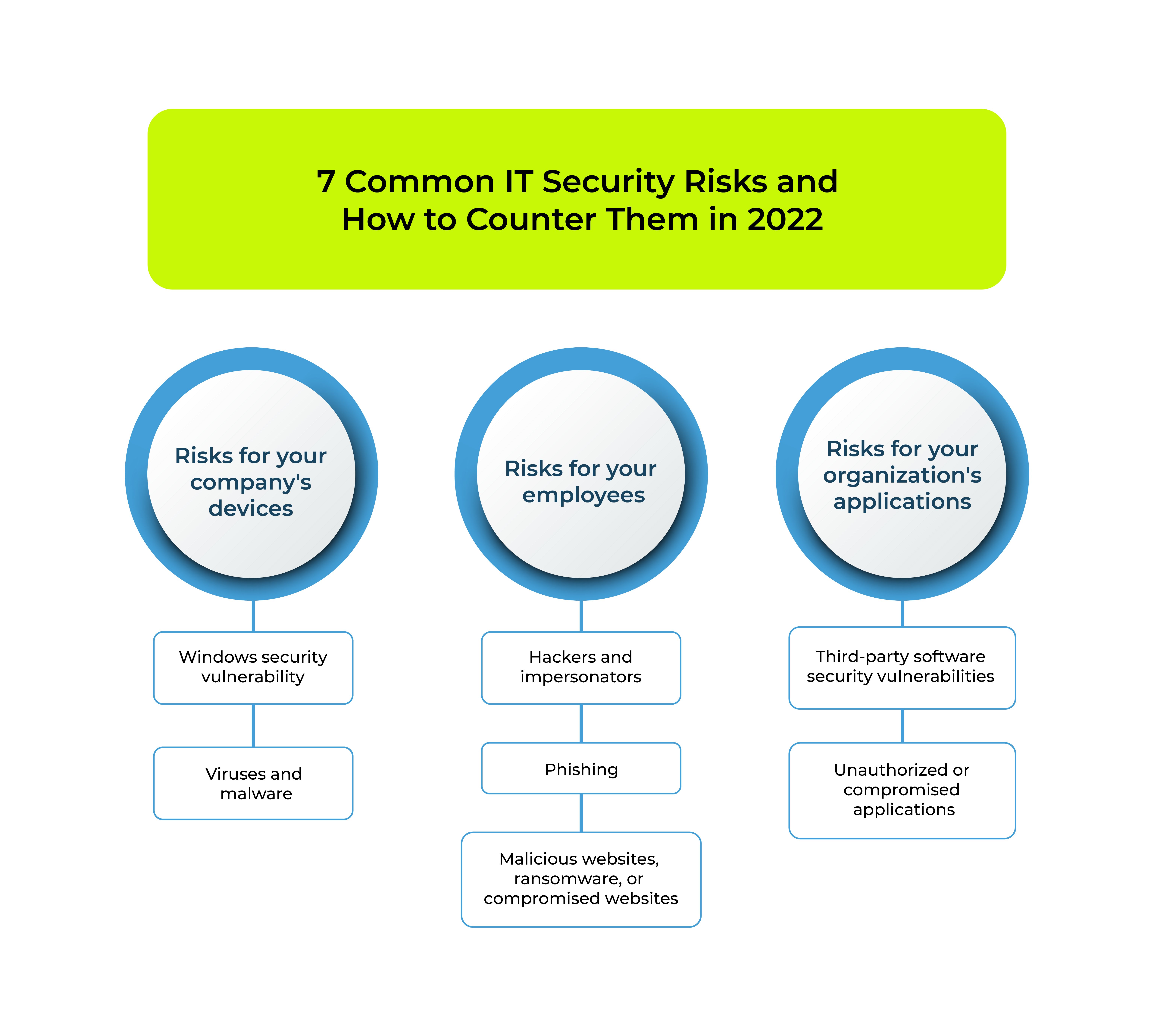
7 Common IT Security Risks and How to Counter Them in 2022
By Chris Morino
Every new year brings us new and improved technology, but it also brings new challenges for your IT infrastructure. The top seven security risks of 2022 can be broken down into three main categories: devices, applications, and humans. We'll go over these trends in cybersecurity that may pose the biggest risks for your business in 2022 and show you the steps you can take to avoid them.
Risks for your company's devices
We've got to start with the basics: your computer itself. Cybersecurity and infrastructure security begin with protecting your company's network by keeping your employees' operating systems secure.
1. Windows security vulnerability
What it is:
No operating system is perfect, but if your systems are out of date, it creates increased opportunities for people to find vulnerabilities in your system and exploit them for their gain. Plus, people are always finding new ways to get access to computers, even on the most up-to-date software! That's why Windows releases lots of patches and security updates to address any newfound security vulnerabilities.
What you can do about it:
Patch management should be an essential part of your cybersecurity plan for 2022. As vulnerabilities in an operating system's security are discovered, patches are created to reduce or eliminate the security risks. Patch management will entail someone on your IT team keeping an eye out for new patches and updates, making sure your systems are up to date, and ensuring that new patches are installed throughout the company in a timely manner.
2. Viruses and malware
What it is:
We’ve all heard of computer viruses and malware. Unfortunately, they are just as big of a threat in 2022 as ever. Once viruses and malware gain access to one computer on your network and begin running their program, they can "infect" other computers on your network. One virus can compromise the security of your entire company by stealing confidential information, tracking your keystrokes and behaviours, spamming your customers and contacts with emails to infect more devices without your knowledge, or even breaking down your company's computers entirely.
What you can do about it:
Anti-virus software can spot suspicious programs that humans might not be able to, and investing in software that scans and counters the most common computer viruses is the best way to protect your business. If you already have antivirus software, make sure you keep it up to date.
Risks for your employees
Not everyone is technology-savvy. Sometimes, your employees can fall victim to phishing, malicious websites, or even hackers and impersonators without proper IT training and some cybersecurity solutions that can address the most common risks.
3. Hackers and impersonators
Who they are:
Hackers aren't as exciting as they seem on TV, but they are definitely still a security risk for your company in 2022. Rather than sitting behind a computer typing or strings of numbers to "break in" to your systems, hackers today just use your employees to get the information they need to log in normally. They may call your employee and claim to be a member of your IT team to gain access to their computer, or they may steal login credentials to gain access to your company’s technology through phishing, malicious websites, or other means.
What you can do about them:
Set up multi-factor authentication for your business as soon as possible. The more hoops a hacker needs to jump through to gain access to your company’s information, the less likely they are to do it. Your company can utilize both social and technological two-factor authentication to avoid most of today's hackers. Suppose someone calls or emails your employee out of the blue. In that case, there should be a social protocol that every employee is aware of to verify their identity–which is more important than ever with more and more companies operating remotely. Additionally, your company should have two-factor authentication for logins on your software and networks to keep unwanted visitors and malicious code out.
4. Phishing
What it is:
Phishing is one of the most common–and most concerning–security threats that will continue to plague companies in 2022. It is often in the form of a person trying to appear like a legitimate source, via email, text, or phone call, to gain information from your employees.
What you can do about it:
Phishing protection is two-pronged: helping keep phishing emails and links away from your employees through robust email filtering while also training employees to recognize and avoid common phishing attacks. Even the best-trained employees can make a mistake, but it shouldn't compromise your business' safety. Email filtering can stop phishing at the source.
5. Malicious websites, ransomware, or compromised websites
What it is:
One of the biggest rising trends in security risks leading into 2022 is ransomware, which shuts down your systems, locks your files, and/or threatens to share your information unless you pay a certain amount to unlock it again. Ransomware is often downloaded--without your knowledge--from malicious or compromised websites. These websites can also steal log-in credentials and other sensitive information from your business.
What you can do about it:
Use DNS and web filtering to block malicious websites from being accessed on any company computers, avoiding ransomware at the source. These tools are commonly used to block unproductive or inappropriate websites from employees, but they can also be a great asset for your IT infrastructure security.
Risks for your organization's applications
Every business needs various software applications to operate based on your industry, but these applications come with their own potential security risks.
6. Third-party software security vulnerabilities
What it is:
Using third-party software to keep your company running is a must, but not all third-party applications are safe. Similar to operating system vulnerabilities, your software has vulnerabilities that need to be addressed and patched before it compromises your business’ security.
What you can do about it:
Keeping applications up to date is the best way to address these vulnerabilities, so having someone on your IT team check in with all employees to ensure updates are happening as planned is the best way to keep your system safe.
7. Unauthorized or compromised applications
What it is:
When you give your employees computers, they'll want to customize them to their tastes, which often includes downloading their favourite apps and software, but sometimes these apps may gain more access to your business' information than you like. How can you make sure that all of the wide variety of apps your employees want to install are safe?
What you can do about it:
There are two main ways your company can address unauthorized applications: App whitelisting and an application control firewall. App whitelisting helps you identify trusted app sources and not download malicious software unintentionally, and there will be a built-in system to ensure unsavoury apps don’t get downloaded to your business’ computers, intentionally or unintentionally. An additional layer of security is an application control firewall, which prevents unauthorized communication and transmission of data from apps to protect you from any malicious or compromised software on your device.
Now that you know about the most common security risks your company is likely to face in 2022, you can begin developing a cybersecurity and infrastructure security plan to protect your business. You should start by making sure your operating system is secure, providing training and resources for employees to avoid common security pitfalls, and then evaluating the applications on your devices for security.



